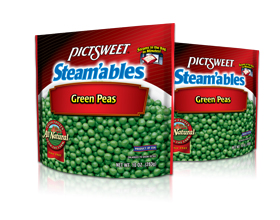On a recent visit to Salisbury, MD, I had the chance to visit the Perdue Innovation Center where they are secretly developing the next great thing in chicken. Stay tuned for more. In the meantime, you’ll laugh out loud when you watch the vintage commercial.
Month: July 2012
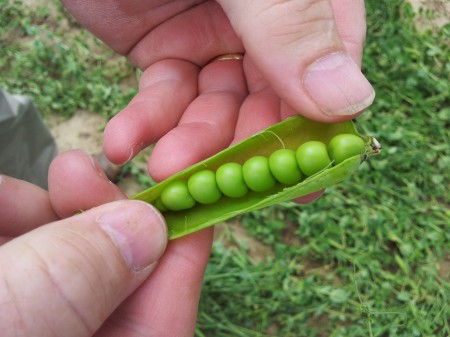

On a trip to Delaware in early June, I had the privilege of observing the process of harvesting and freezing peas with Delaware Department of Agriculture Secretary, Edwin Kee. We toured a pea farm near Milford and the PictSweet pea freezing and packing facility near Bridgeville. Mr. Kee explained that peas are a cool weather crop. They are planted in February/March and harvested in early June.
On this early June day, Delaware is abuzz at how amazing the pea yields are this year. Pictsweet tells us they are on track to harvest over five and half million pounds of peas in Delaware this spring. That’s right. 5.5 million pounds. They are pulling in peas at a rate of 3,500 lbs/acre. That’s the best pea yield in Delaware 10 years. The long, cool spring which featured a warmup in the middle hit it just right.
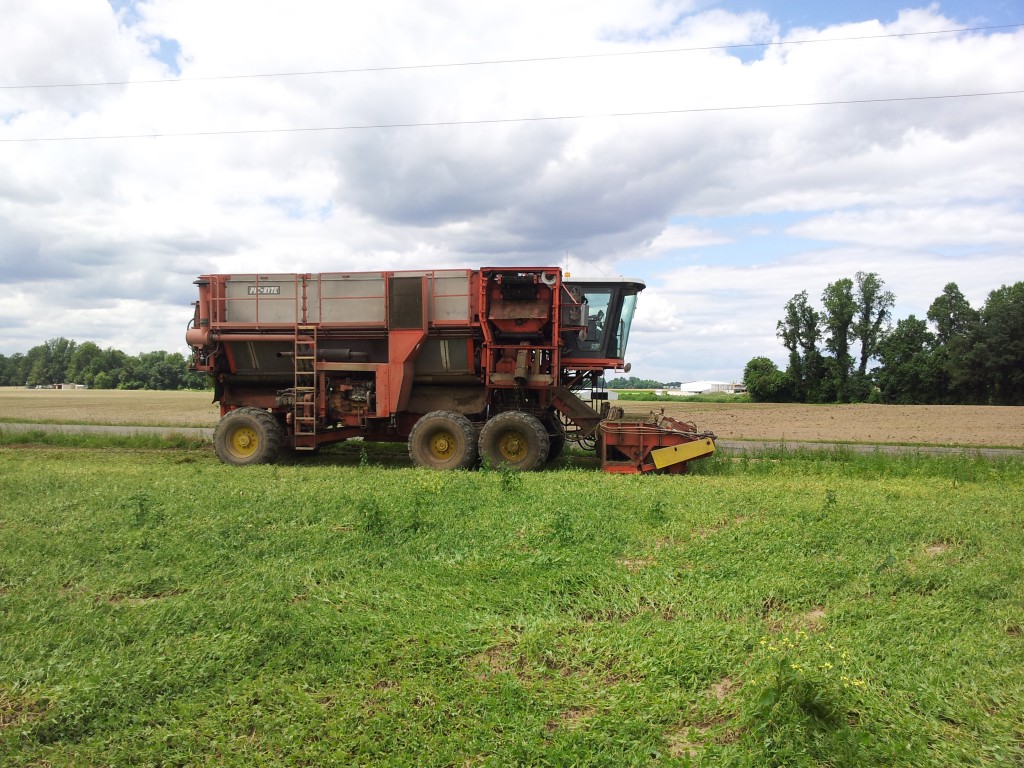
What do you do when you’re pulling 3,500 lbs of peas off of every acre? You quickly transport them to the freezing plant for sorting, grading, washing, washing, more sorting, more washing, blanching, flash freezing and storing. Peas typically move from field to frozen in 4-6 hours. Can you believe it? 4-6 hours. I’ve always heard that frozen is more fresh than fresh. Now I know what that means.
The equipment involved in moving millions of pounds of peas in just a short harvest window would blow your mind.
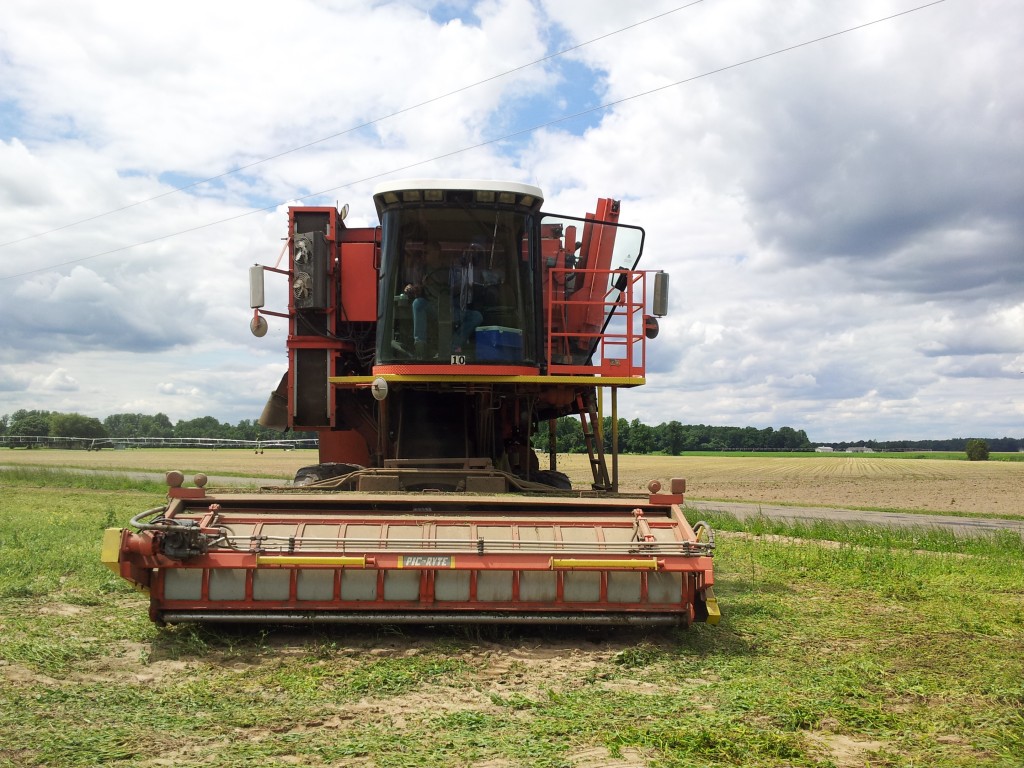
1) First there is the harvester. This machine can also operate as a lima bean harvester. Each one of these harvesters will set a farmer back about $400,000 and there were 3-4 of them working this field this afternoon. It doesn’t just pull the pea shoots up off of the floor of the field, it sucks them up, rotates them in a drum, beats on them at just the right pressure to make the peas pop out of their shells and diverts the shoots away from the peas to dispose of them on the ground. It preserves the shelled peas which are then transfered to a large dump truck headed for the processing plant.
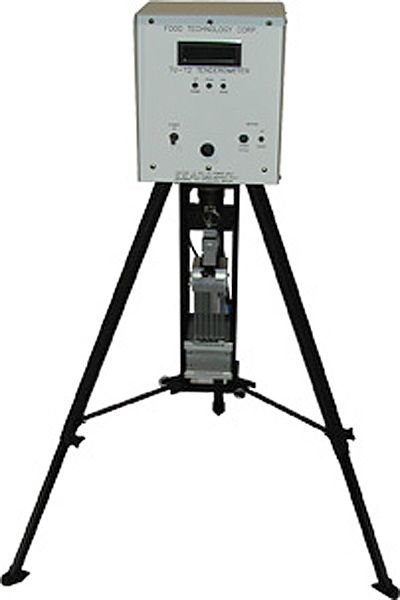
2) The next piece of equipment the pea encounters is the tenderometer. That’s right a tenderometer. Once the peas arrive at the plant, the size and tenderness of the peas are measured to determine their maturity and their value. The price paid to the farmer is decided here. In the grading room, one by one, a few shelled peas are put into a Tenderometer for measuring. Invented at the University of Maryland after World War II, the device literally measures how tender the peas are. Tender peas that are the right size get frozen. Starchier, stiffer peas might go to canning where they will hold up well during the canning process. Once the price is determined, the entire truckload gets dumped onto a conveyor belt outside the plant and the processing begins.

3) Up next: The sorting and washing starts on the pea processing line. I was not permitted to photograph this part of the tour, but the Pea Processing Line pictured above is for sale at a farm equipment website called http://alibaba.com. It resembles what I saw.
This line starts right at the outside of the building where the drucks drive in and dump their loads and then the line snakes through the building and continues to get more and more refined. Peas are moving a mile a minute along these conveyor belts and the machinery is loud. Employees where hair nets and protective equipment for their ears. Mr Kee explained that when he was a young graduate student, 30 years ago, working on improving the tenerometer, he would stop by the plant and their would be 75 people working the line. Now it takes only about 25 people. The machinery has replaced the need for humans to do any of the manual sorting of the peas.
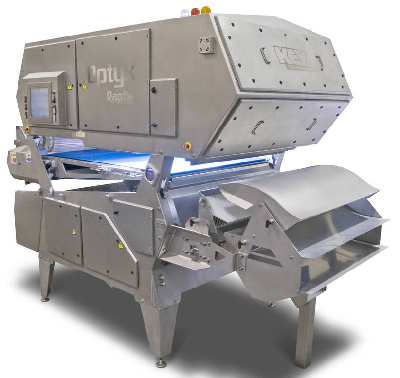
4) The next piece of hi-tech equipment on the line? The Optical Sorter. You won’t believe what this machine is capable of doing. Peas fly through this machine at incredibly high speeds. Peas that don’t deserve to make it into a PictSweet frozen bag of peas must be sorted out. In the early stages of the line, they are more crudely bumped out, sifted out or blown out, but once inside, the sorting must get more precise. This device takes an individual picture of every pea (there are billions going through in a day) and in the time it takes the pea to enter the scan area and get photographed, the machine is able to send a signal so that peas that are the wrong size or blemished in some way are blasted with a precise laserlike blast of air. That blast of air kicks that singular pea out while allowing the rest to pass through. Did you get that? Photo, signal, air blast, bad pea gone.
The rest zoom on their way through wash after wash, a quick steam bath at about 210˚F for 2-3 minutes, then more washing and finally flash freezing. At this plant the peas are put into large, 3ft. by 3ft. plastic lined cardboard boxes and stacked in a warehouse for storage. They aren’t put into the consumer size bags you see below at this plant. They wait until they are ready for distribution at retail grocery stores before packing them in the consumer sized bags.
The frozen pea storage warehouse reminded me of winery caves, because there were rows and rows of stored product that stretched into the distance. Each box is barcoded and the field of origin and date of processing are recorded.
Vegetables make up about 6% of Delaware Agricultural revenue. The highest portion of revenue comes from the Poultry Industry which makes up 74%. Vegetables grown for processing (freezing and canning) earn Delaware farmers about $28,000,000/year and use about 30,000 acres of land. Before canning, freezing, and distribution technology existed at scale, farmers had no incentive to grow more produce than their families could consume. It’s only through these distribution channels and preserving technologies that farmers could produce excess and earn a profit. The last ten years have brought consolidation in the industry and there are now only 4 vegetable processing companies left in Delaware. PictSweet is one and it processes more than just peas. A national company, they are sourcing product from Tennessee, California and elsewhere, but in Delaware, in addition to peas, they are processing lima beans, corn and green beans.
To learn more about the Pea Production in Delaware, I invite you to read this article published by the University of Delaware: Pea Production for Processing on Delmarva.
Some of my favorite Pea Recipes. Click on the photo to be redirected to the recipe.

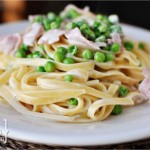
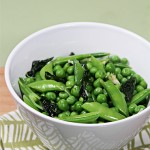

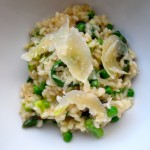
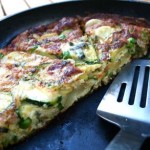

I have 2 kids. A boy who is 7 and a girl who is 4. We’re lucky. They are not overweight. They are healthy. We work hard to put a variety of foods in front of them every day and to encourage fresh vegetables and fruits, whole grains and low-fat protein. We have meatless meals and Dad is a vegan. So what am I doing taking my kids to McDonald’s, you ask?
McDonald’s is on a mission. Just ask Scott Rodrick. He has spent more than 20 years building a franchise of more than a dozen McDonald’s locations in San Francisco. His father was one of Ray Kroc’s earliest franchisees, opening the first McDonald’s in South Florida in 1950. If anyone has witnessed firsthand the changes that have taken place at the McDonald’s corporation, it’s Scott Rodrick.
He was generous enough to give a few food bloggers/writers a tour of one of his San Francisco McDonald’s and to explain just what’s been going on over the past few years. The tour, and the menu sampling that occurred afterwards were eye-opening for me. Now when I’m on the run looking for a healthy snack, I actually think, McDonald’s. Crazy. Right?
Here’s why it’s not as crazy as it sounds:
1. McDonald’s sources its fresh ingredients from the same places my supermarket does. Bagged Greens? Yes. Blueberries from the Central Valley? Done. Major Brand Apple Slices? You got it.

I assume that the fresh blueberries they’re putting on top of the Blueberry Banana Nut Oatmeal won’t be on the menu year-round, but they’re here now. These aren’t freeze-dried blueberries reanimated when hot water touches the oatmeal. These are true, fresh blueberries delivered almost daily to your local McDonald’s and sprinkled on top after the oatmeal is ready. See below for more about what the inside of a McDonald’s walk-in refrigerator is like and how the produce is stacked neatly in small packages. Just like home, but better.
2. Egg McMuffins are made with eggs that are cracked right onto the griddle.
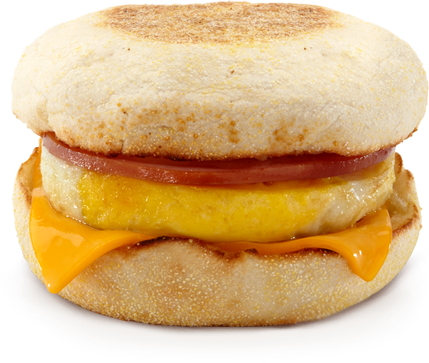
I know. Right? The cooks crack the egg into a little nonstick fry ring like the kind you can buy at Williams-Sonoma. Want to cut down on the fat and calories in an egg McMuffin? Ask them to hold the cheese or hold the ham or both. Also, the English Muffin part has Margarine in it. You could ask about not using the Margarine, but I think it is literally in it, so remove one of the pieces of bread and eat it open top. Altogether, the one pictured here contains 300 calories and 12 grams of fat. No cheese brings it down to 250 calories and 9 grams of fat. I can live with that once in awhile.
Watch a video of how they grill the eggs for an egg McMuffin
3. My kids eat the apple slices and don’t finish their fries.
 |
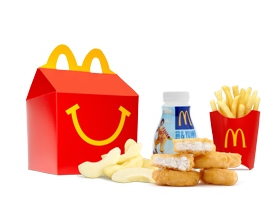 |
In early 2012, McDonald’s modified the happy meal and reduced the french fry serving size to 1 oz (100 calories). They added a bag of apple slices to every meal too. In San Francisco, to comply with a “no free toys” law, they started charging 10 cents for the toy and donating the proceeds to build a new Ronald McDonald house at UCSF. Not a bad solution.
We usually substitute bottled water (for a modest surcharge) for the milk. And you can also request 2 bags of apple slices instead of the 1 bag each of apple slices and fries. My kids are normal “kid eaters”, but they have really turned on to apple slices and are happy to forgo the fries. Worried about salt? Ask for your fries salt-free. It takes a little longer to get the meal, but fries are made every 7 minutes at McDonald’s, so you can get yours fresh, hot and salt free and never wait longer than 7 minutes.
4. Sure the strawberry banana smoothie has a lot of sugar in it, but so do smoothies everywhere else and the ones at McDonald’s have the most vitamin C. For the record, my kids order the small strawberry-banana smoothie which is a 12 oz drink clocking in at 210 calories.
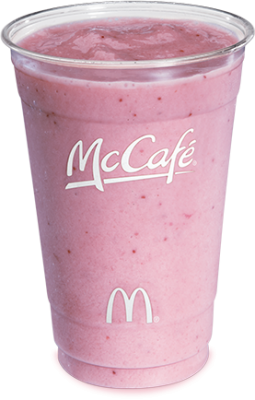
This is a special treat for my kids and one that replaces getting a milkshake or an ice cream cone (something we rarely, almost never do). Given that, the 44g of sugar 1g of fat and 210 calories don’t seem so bad.
Ever wonder just how much sugar there is in the fruit smoothies you’re out there consuming? Well, I decided to compare Jamba Juice, Starbucks and McDonald’s. Each offers a 16 oz strawberry banana smoothie. Here is how they compare:
 |
 |
 |
| 16 oz Strawberry Smoothie | 16 oz Strawberry Alive Smoothie | 16 oz Strawberry Banana Smoothie |
|
Calories: 300 cal Total Fat: 2g Total Carbs: 60 g Dietart Fiber: 7g Sugars: 41g Protein: 16 g % DR Vitamin C: 35% |
Calories: 250 cal Total Fat: 0g Total Carbs: 50 g Dietart Fiber: 2g Sugars: 42g Protein: 11 g % DR Vitamin C: 60% |
Calories: 260 cal Total Fat: 1g Total Carbs: 60g Dietart Fiber: 3g Sugars: 54g Protein: 2g % DR Vitamin C: 90% |
5. The signature salads totally rock, as long as you’re not going to try to eat one in the car while driving.
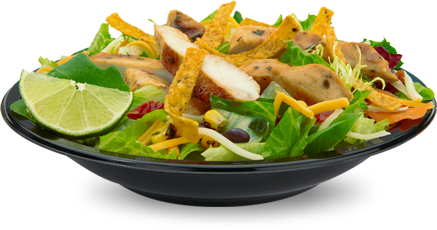
McDonald’s doesn’t use preservatives in the bagged salad greens and they are delivered in regular sized bags. When you order a salad, there is a cook in the back who assembles it then. They put greens into a bowl, then sprinkle tomatoes on top, the beans, the little tortilla strips and finally, they slice a freshly grilled piece of chicken and place it on top.
Looking to control calories and fat with your salad? Skip the croutons and drizzle half of the dressing packet over the salad instead of the whole thing. Make sure you get the grilled chicken, rather than the crispy chicken.
6. The fruit and walnut salad is a great snack for the kids. It is the most hidden item on the menu. Even most employees don’t realize it’s there, but if you ask for it by name, they can find it.
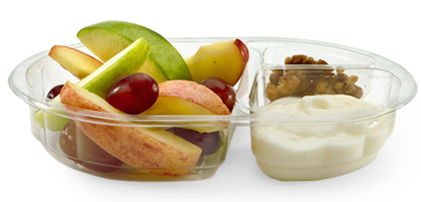
The vanilla yogurt is yummy and low fat and has helped my children get over their fear of plain yogurt. This snack demonstrates to them that fruit, nuts and yogurt are a satisfying snack. It’s easy to handle in the car too.
7. The Honey Mustard Snack Wrap with Grilled Chicken is only 6 Weight Watchers® Points Plus™. I can order that when I’m driving and can’t order a signature salad.
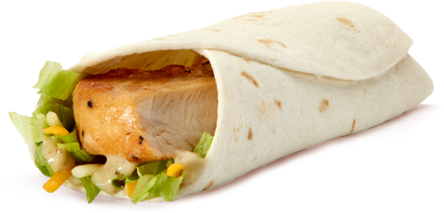
This was a standby emergency snack the last time I did Weight Watchers. I lost 18 lbs. It helped me get over my double quarter pounder with cheese obsession.
8. The Fruit & Yogurt Parfait is a great dessert or snack. At only 150 calories and 2g of fat, what’s the big deal? It tastes great.
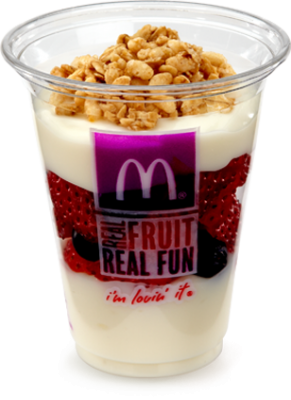
Another item to help introduce your children to the concept of fruit and plain yogurt. You can transition them over to organic ones that are less sugary once you convince them it’s a yummy breakfast or snack item in the first place.
9. You can ask for stuff just how you like it. No salt? Check. No mayo? Check.

Want another option that really doesn’t set you back calories and fat-wise? Try the Premium Grilled Chicken Classic Sandwich, but order it without the mayo and you’ll cut 5.5 grams of fat off of the total. Wonder how I know this? The McDonalds.com website features a nifty tool where you can deselect ingredients from any item on the menu and it will retally all of the nutritional information right in front of your eyes. See the Premium Grilled Chicken Classic Sandwich Nutrition tool here. The tool is a little buried. You will have to click on a little red plus sign next to the word Nutrition to get the tool to slide out. Once you get access, you’ll be amazed at how effectively you can cut fat and calories by eliminating mayo-based sauces and cheese. I also recommend eliminating half of a bun whenever possible.
10. The kitchens and pantries at McDonald’s are immaculate.
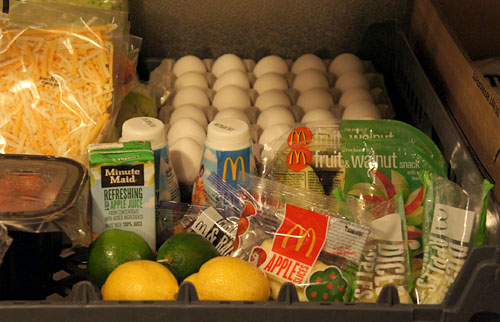
I toured a downtown San Francisco location right after the lunch-hour rush and everything was clean as a whistle. I expected the walk-in refrigerators to be stacked floor to ceiling with product, but that’s just not the case. Their walk-in fridge was more orderly and clean than my fridge at home. McDonald’s receives almost daily shipments, so no one shipment has to be too large. Fresh produce is picked at the farm, triple washed and delivered to McDonald’s locations within just a couple of days.
In the walk-in, we saw eggs in cartons by the dozen. A few bags of fresh greens, Maybe 10-15 fresh packs of individual serving blueberries and so on. If I hadn’t seen it for myself, I might not have believed it. We weren’t allowed to photograph it, but a nice kid from Connecticut was allowed to photograph it. His photo looks exactly like what we saw.
I’m impressed that McDonald’s is making such a huge effort to improve nutritional quality of their foods and that they are willing to invite small groups of people into their kitchens to see their efforts firsthand. Not every fast food chain is cutting salt and fat. Go to Carl’s Junior and get a The Amazing Grilled Cheese Bacon Six Dollar Burger™ and it will set you back 80g of fat!! and over 1000 calories! And that’s just for the sandwich. On the McDonald’s menu, the most fat grams you’ll encounter are about 40g for many of the bigger cheeseburgers. That is more fat that you should have in a day, so if you’re going to go the cheeseburger route, you gotta do it sparingly. The Double Double I like at In-And-Out Burger has 41 grams of fat, so even though everyone praises In-And-Out, they’ve got the same fat content as a McDonald’s Double Quarter Pounder.
All this to say, you can make healthy choices at McDonald’s if you try and you’re aware. And I’m surprised to find that it’s easier than ever and easier than elsewhere to do that for myself and my kids at McDonald’s.


